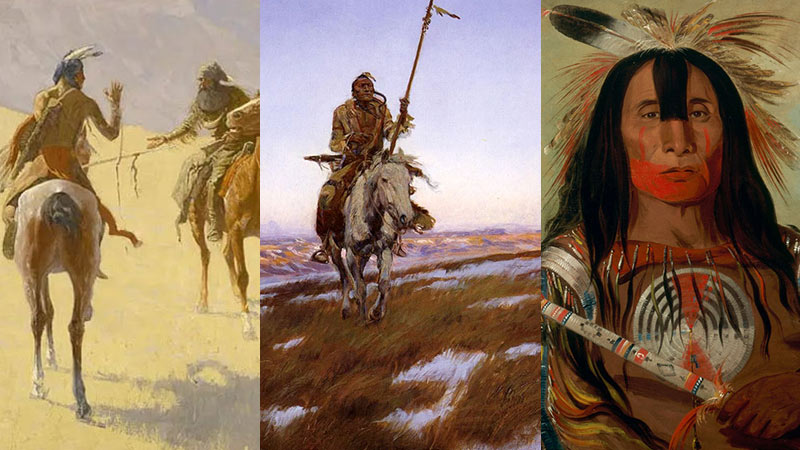
Native American art is a vibrant tapestry woven from centuries of tradition, culture, and storytelling. This rich artistic heritage has inspired countless contemporary artists, creating a unique blend of traditional themes and modern techniques.
From the striking landscapes to the poignant depictions of tribal life, Native American paintings offer a window into the soul of a people deeply connected to their history and environment.
In this exploration of ten famous Native American paintings, readers will discover the powerful narratives behind each artwork.
These pieces not only reflect the beauty of Native American culture but also highlight the resilience and creativity of its artists.
Whether it’s the bold colors of tribal attire or the serene landscapes that capture the essence of life on the plains, each painting tells a story that resonates with viewers around the world.
1. The Last of the Buffalo – Albert Bierstadt
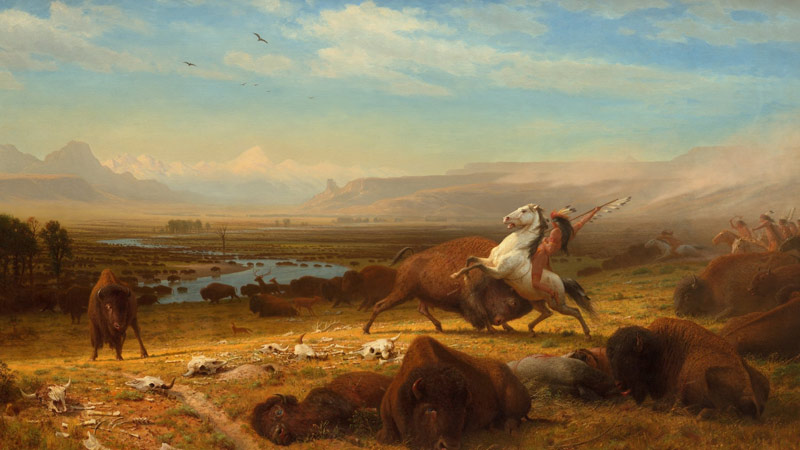
Albert Bierstadt’s The Last of the Buffalo is a monumental painting measuring 6 x 10 feet. Created in 1888, it powerfully illustrates the impact of westward expansion on Native American life.
The vibrant composition features buffalo migrating across the plains, with one fierce creature confronting a Native American hunter.
This scene not only represents the dwindling buffalo populations but also symbolizes the rich Native American culture facing extinction, highlighting the coexistence of beauty and struggle in their history.
2. When Blackfoot And Sioux Meet – Charles Marion Russell
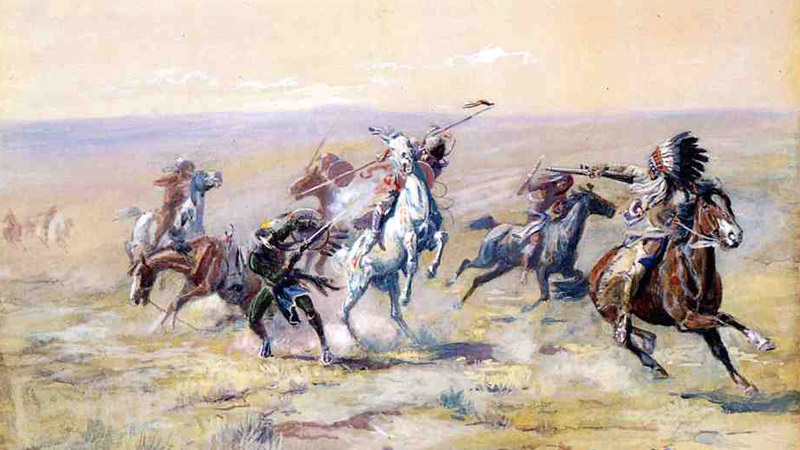
Charles Marion Russell created “When Blackfoot And Sioux Meet” in 1908. This dynamic painting captures an intense battle between two tribal factions, showcasing the fierce struggle of the Blackfoot and the Sioux.
Russell’s mastery of detail and motion creates an action-packed scene, highlighting the warriors’ use of traditional tomahawks plus to firearms.
This work not only illustrates the historical context of tribal conflict but also reflects Russell’s deep respect for Native American culture.
3. The Buffalo Hunt – Frederic Remington
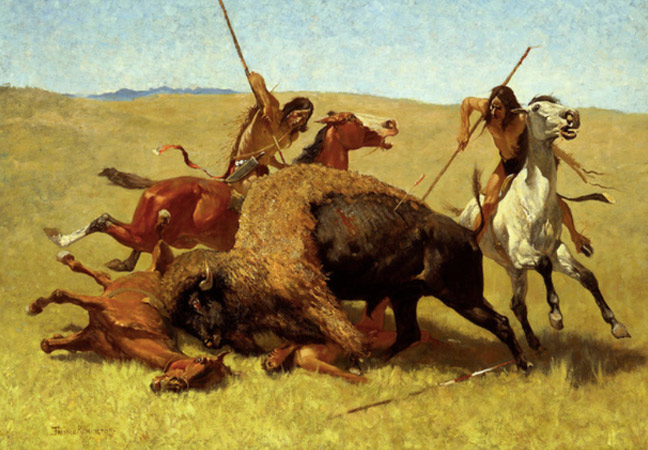
Frederic Remington’s The Buffalo Hunt captures the essence of Western hunting traditions. This striking painting, created in the late 19th century, showcases a tribal hunting party engaged in the intense task of buffalo hunting.
Remington’s vivid use of color brings the scene to life, highlighting the relationships between Native Americans and their environment.
The skilled portrayal of movement emphasizes the urgency and excitement of the chase, reflecting a unique cultural practice that is distinctly Western.
4. Buffalo Bulls Back Fat, Head Chief, Blood Tribe – George Catlin
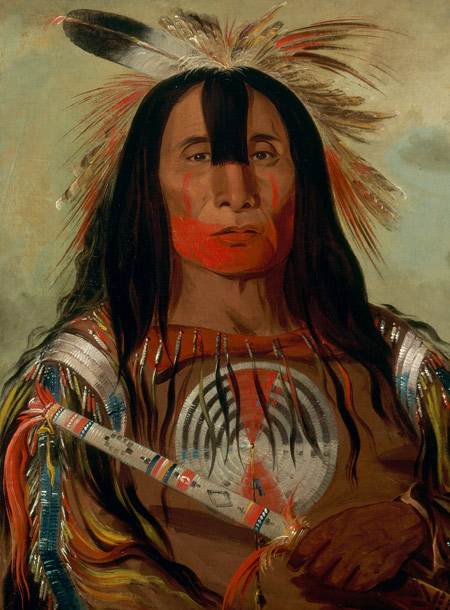
George Catlin painted Buffalo Bulls Back Fat, Head Chief, Blood Tribe in 1832. This artwork features a respected chief of the Blood Tribe, showcasing his elaborate attire.
Catlin’s time spent among various tribes allowed him to capture the essence of Native American identity during a transformative era.
The painting reflects not only the chief’s prominence but also the importance of buffalo in the daily lives of the Plains Indians, emphasizing both cultural heritage and community pride.
5. Cree Indian – Charles Marion Russell
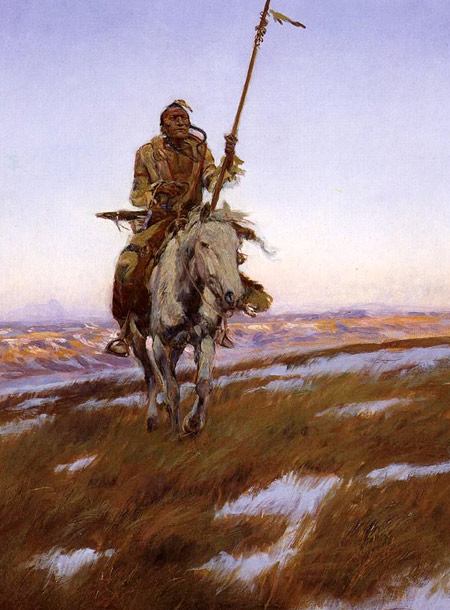
Cree Indian, painted by Charles Marion Russell in 1905, powerfully captures the essence of the Native American experience.
This artwork features a lone elderly Cree man riding a horse across a cold, desolate hillside, symbolizing the fading culture of the Cree nation.
Russell’s skillful portrayal reflects both the harsh realities faced by the Cree people and their enduring spirit.
The painting evokes deep emotion and highlights the transition from a vibrant tribal life to the struggles of a nation positioned onto reservations, showcasing Russell’s profound understanding of Native American identity.
6. Attack by Crow Indians – Alfred Jacob Miller
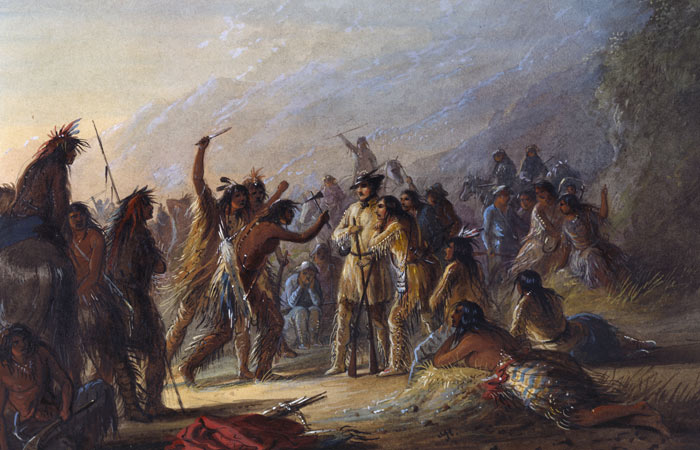
Source: art.thewalters.org
Miller’s Attack by Crow Indians, completed in 1860, vividly depicts a tense encounter with a band of young Crow warriors.
The painting illustrates Fitzpatrick, a determined frontiersman, faced with a crucial decision. Miller captures the moment’s intensity, emphasizing the warning of an old Crow medicine man about striking first.
This artwork reflects the turbulent interactions during the 19th century between Native American tribes and settlers, infusing historical context with engaging storytelling that exemplifies Miller’s artistic prowess.
7. Scene from ‘The Last of the Mohicans’: Cora Kneeling at the Feet of Tanemund – Thomas Cole
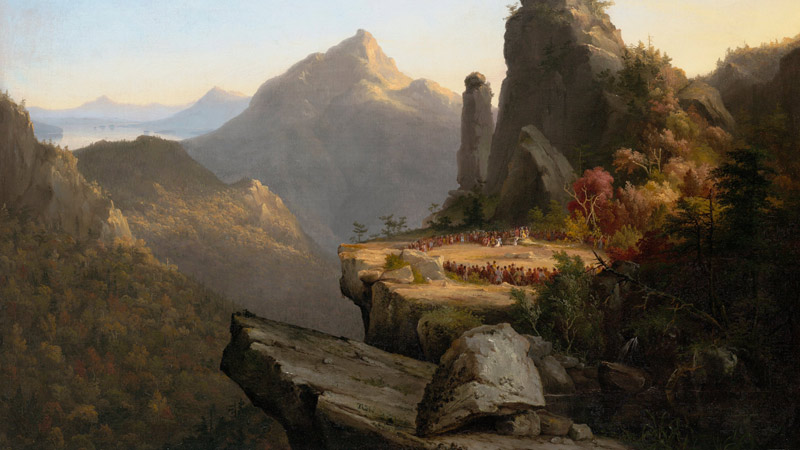
Cora Kneeling at the Feet of Tanemund is a significant painting by Thomas Cole, illustrating a pivotal moment from James Fenimore Cooper’s novel.
The artwork captures Cora’s submission to Tanemund, embodying themes of cultural intersection. Cole’s detailed brushwork emphasizes the emotional gravity of the scene, showcasing the tension between Native American characters and European settlers.
The majestic backdrop of White Mountain enhances the drama, symbolizing both beauty and conflict in Native American history. This painting highlights Cole’s ability to merge landscape and narrative, making a lasting cultural impact.
8. The Parley – Frederic Remington
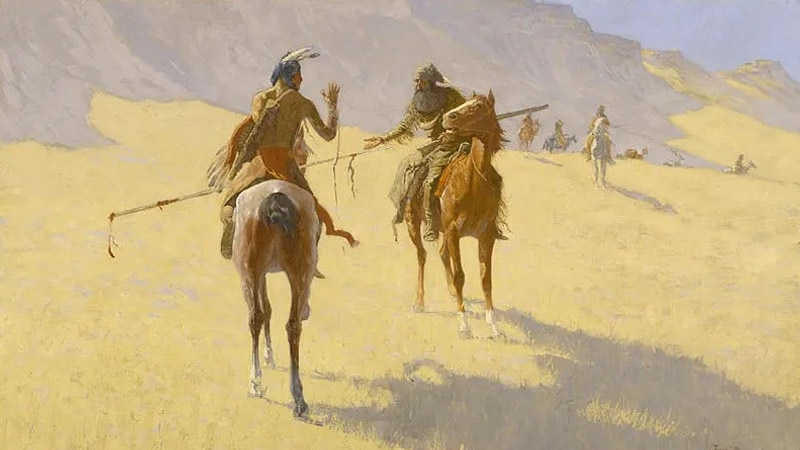
Remington’s The Parley, created around 1903, vividly captures a historic moment. It depicts a meeting between a Native American tribesman and a bearded frontiersman, both mounted on horseback.
The painting symbolizes the attempt to establish peace amidst conflict, showcasing the contrasting yet respectful attire of both men.
Remington’s expert use of color and detail invites viewers to appreciate the cultural significance of dialogue in bridging divides, reflecting the broader narrative of cooperation and understanding in the face of adversity.
9. Indian by Firelght – Eanger Irving Couse
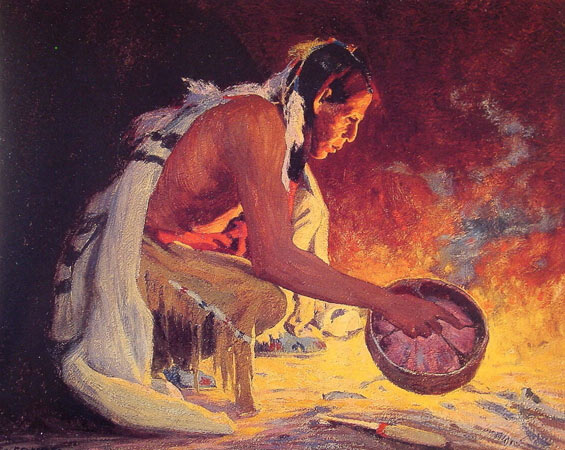
Source: commons.wikimedia.org
Eanger Irving Couse’s painting Indian by Firelight, created in 1921, captures the tranquility of Native American life in a striking and intimate manner.
The scene depicts a Native figure illuminated by the soft glow of firelight, emphasizing the connection between the individual and their environment.
Couse’s use of warm tones and realistic textures highlights both the peaceful atmosphere and the cultural significance of the fire as a gathering place.
This artwork starkly contrasts with more sensationalist depictions, providing a respectful portrayal of Native American traditions and heritage that honors their lived experiences.
10. Plains Indians Hunting in Winter Landscape – John Hauser
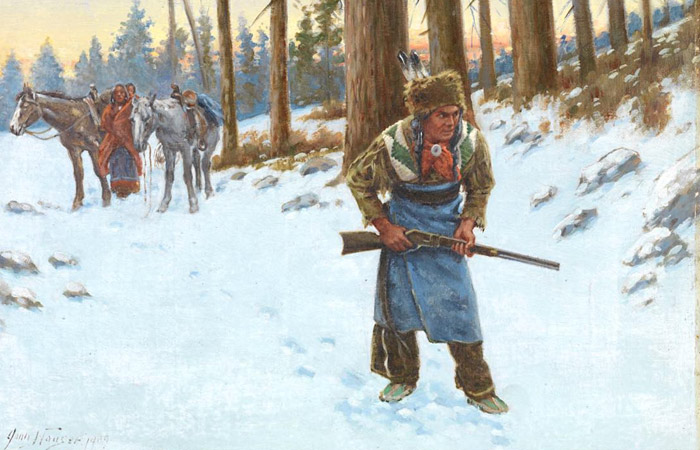
Source: jigidi.com
John Hauser’s Plains Indians Hunting in Winter Landscape captures a serene yet powerful scene of Native American hunters amidst a winter backdrop.
The painting showcases the resilience of the Plains Indians as they navigate their environment. Hauser’s attention to detail emphasizes the warm, muted tones of the hunters’ attire against the stark white landscape.
This artwork serves as a tribute to the survival skills and cultural practices essential to Native American life during harsh winters.
Hauser effectively blends realism with respect, inviting viewers to appreciate the deep connection between the hunters and their land.






